When you’re overwhelmed with everything work and life has lobbed on your plate, simply deciding what to do first can require as much time and mental energy as actually doing it.
How can I excel at work while maintaining my close friendships?
How can I get enough sleep while striving towards my goals?
How can I balance family demands with my own personal well-being?
The antidote to chronic overwhelm is accepting –– really accepting –– that you can’t do everything. Believing you can will just leave you feeling guilty, stressed out, and miserable. Prioritization is the process of embracing the limits of your time and energy, freeing yourself from the expectation that you have to do it all, and taking back control of your to-do list. Ultimately, it's about leading a life that’s aligned with your values.
Prioritization is equal parts mindset, habit, and skill that you can learn to cultivate over time. This article will help you identify areas in your life worth focusing on. We’ll dive into the best ways to prioritize daily, how to build a prioritization system, and productivity methods that will help you put importance over urgency.
Things worth prioritizing in life
While specific priorities will vary from person to person, there are a handful of general areas that all of us should prioritize in order to function at our best. These are the things that inch us closer to our long-term goals and generally make life worthwhile. Yet, we often let days, weeks, or even months go by without doing them.
It’s important to take stock of exactly what those things are so we can bring them to the top of our to-do lists and the forefront of our focus.
Health and fitness
You can probably relate to the endorphin rush following a good workout or the satisfaction after eating a healthy home-cooked meal. But when life feels like it’s moving at warp speed, healthy habits are often the first thing to go. We put off a walk in the park in favour of scrolling through social media or opt for takeout so we can work later into the evening. It’s not just our physical health either. We let our emotional and mental health slip as we go through the frantic motions of everyday life.
These choices, both intentional and subconscious, add up over time and make it hard to show up in other areas of our lives. Eating convenient junk food keep our energy levels unstable and makes it hard to focus at work. Feelings of anxiety make us snappy with our loved ones.
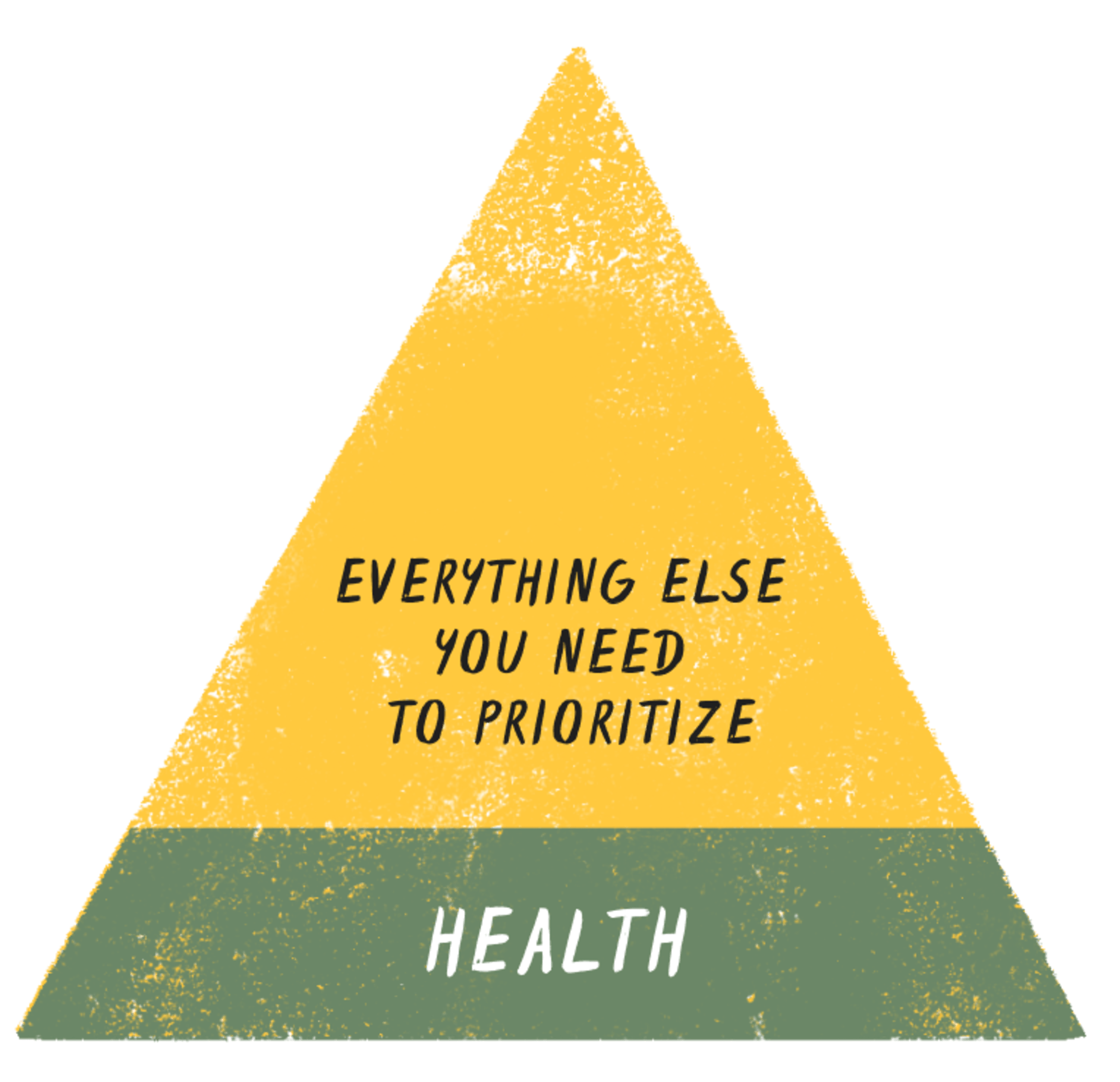
Our health serves as a foundation for everything else. Failing to prioritize healthy eating, exercise, and our emotional fitness eventually catches up with us.
Sleep and rest
Whether you’re a student pulling an all-nighter or a professional working late to meet a looming deadline, sacrificing sleep is a go-to strategy for buying more hours in a day. However, the cost of extra time is often more than we bargained for.
In his book, Why We Sleep, Dr. Matthew Walker, Professor of Neuroscience and Psychology at the University of California and founder and director of the Center for Human Sleep Science, warns of the side effects that arise with inadequate sleep:
- Our emotions become unstable: A study found a 60% amplification on emotional reactivity after sleep deprivation.
- Our learning is impaired: One study found a 40% deficit found in participants ability to make new memories compared to the control group.
- Our cardiovascular system is compromised: Adults 45+ who sleep less than 6 hrs a night are 200% more likely to experience a heart attack or stroke in their lifetime.
- Our hormones become imbalanced: A lack of sleep results in a chronic increase in cortisol and the suppression of growth hormone.
Walker asserts that a lack of sleep affects every major system in our bodies: “cardiovascular, metabolic, immune, reproductive”. While Walker may have overstated the case for sleep, you’ve probably felt the effects of missed sleep for yourself. A day or two of reduced sleep leaves us tired, jittery, on-edge, and unproductive.
Make sleep a priority each and every day with help from these tips:
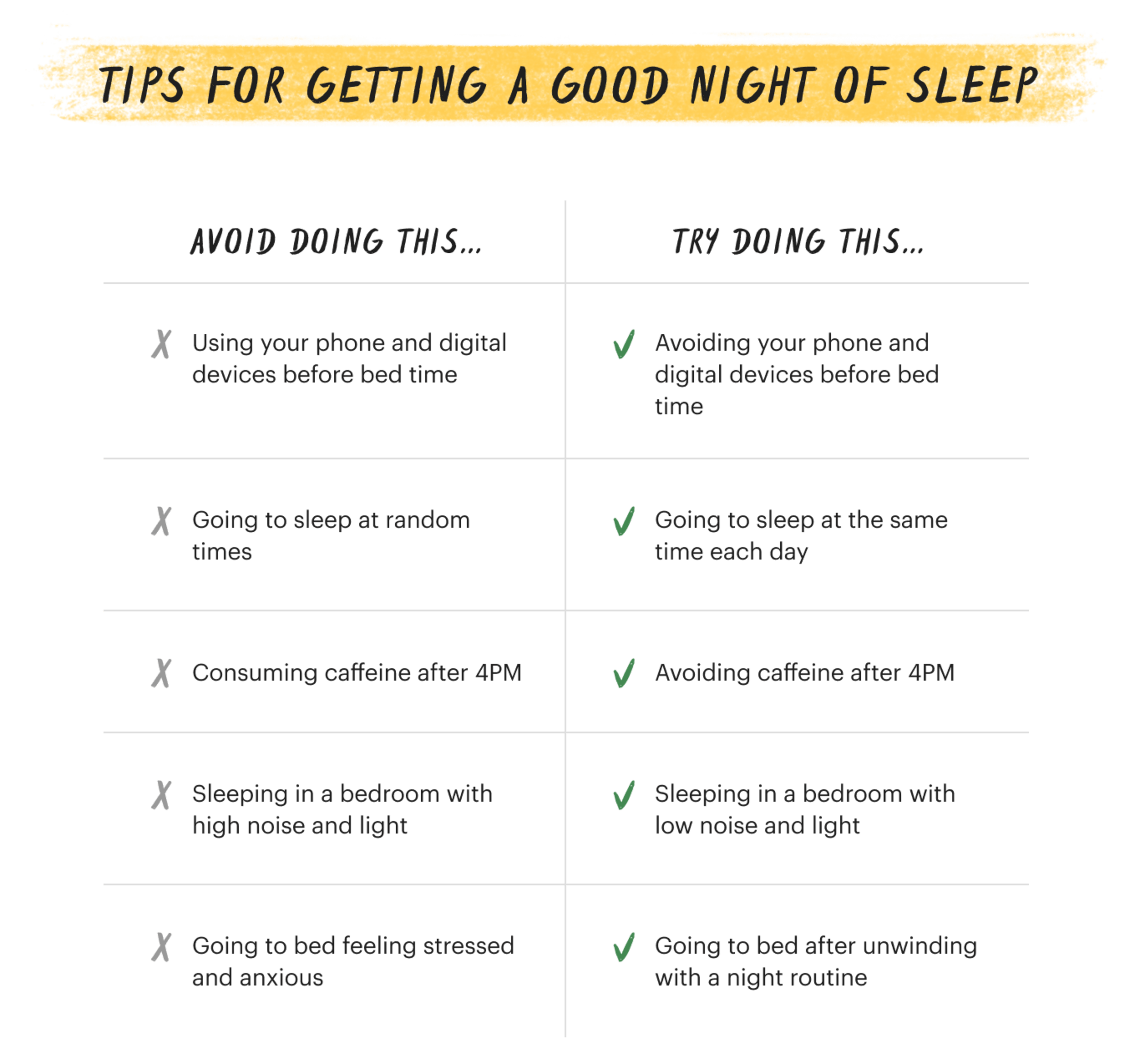
Whatever big tasks on your list that can’t wait, consider a good night’s rest instead. Feeling tired in the morning only serves to start the day unable to meet the challenges ahead.
Friends, family, and relationships
Humans are social creatures who crave connection. Yet, when push comes to shove, we often neglect our friends, family, and significant others, assuming they’ll be around when things get less busy.
But relationships can’t be put on autopilot. It's hard to mend the relationships we’ve frayed – from missing out on our child’s basketball game because of a work meeting to forgetting to wish our sibling a happy birthday because we were occupied with other things. As death-bed confessions reveal, people regret how much time they spent working, and wish they had stayed in touch with friends.
Prioritize spending time with loved ones and nurturing new relationships you think are worthwhile. Here’s a few tips on doing exactly that:
- Make the first move: Don't wait for others to make plans with you. Instead, be proactive about being the connector who invites friends and family members out to catch up.
- Know what’s non-negotiable: While you can't always be there for everything, decide on what you won't miss out on, no matter what. This will vary from relationship to relationship. With your spouse, it could be a wedding anniversary. With a close friend, it could be supporting them at their book launch.
- Remember to reach out: Life gets busy for everyone. While meeting in person isn’t always possible, take advantage of technology to stay in contact with friends and family by phoning, texting, and messaging. Congratulate people on their wins, offer sympathies for their losses, and reach out just because.
Productive work
Many of us want to get ahead in our careers, working in pursuit of promotions and professional advancement. But there’s a difference between working hard and working smart. It’s easy to get stuck in the working hard category — answering an endless stream of emails and work messages, sitting in back to back meetings, and taking any new assignment that comes our way.
But it's working more strategically (“smarter”) — focusing on work in our zone of genius, practising deep work, and being selective about the work we take on (or, better yet, pitching our own projects) — that propels us forward professionally.
At work, it’s common to feel like we’re simultaneously going 100 miles an hour while standing in the same spot. We’re busy but unproductive, spinning but stagnant. This feeling often arises when we fail to be intentional about our growth and prioritize high-impact projects. When in doubt, use this handy flowchart to decide whether a work project is worth putting at the top of your list or should fall to the bottom of your priorities.
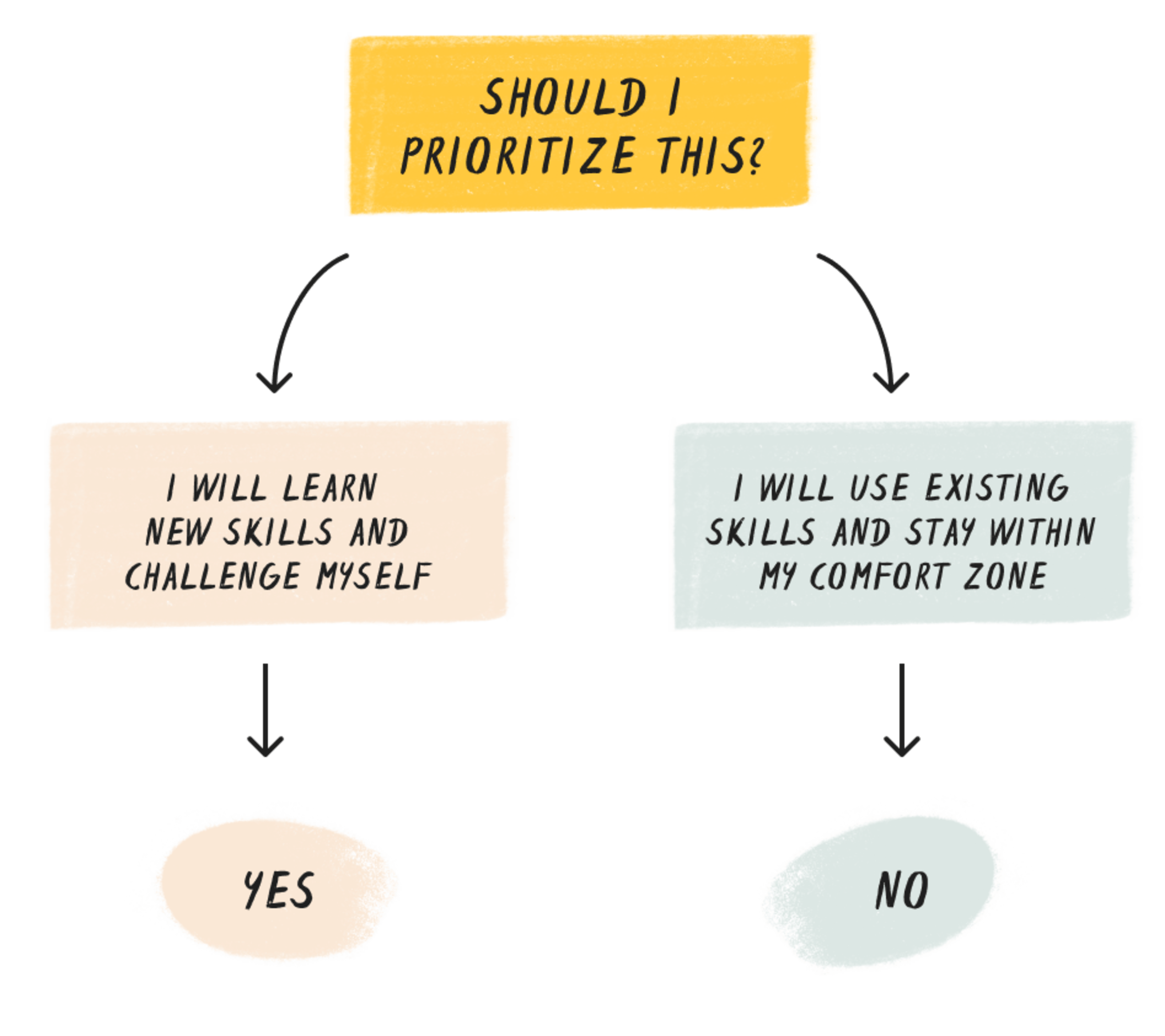
Seek out and prioritize opportunities that allow you to stretch beyond your current capabilities and explore new areas that excite you.
Things to deprioritize
You can't prioritize without deprioritizing, giving yourself permission to move certain things to the bottom of our to-do lists and the back of our minds. By intentionally taking our focus away from the areas in our life that are distracting, opens up more time and mental energy for what matters.
Social media and entertainment
Prioritization is necessary because there's only so many hours in the day. However, there’s something to be said for re-capturing how much time we really have. We spend hours swiping through TikToks or falling down YouTube rabbit holes that we could use working on our side projects or socializing with friends. Many of us spend more time on social media and entertainment then we would like to admit.
While they can add fun to our days, it’s worth reducing how much time we spend on distracting websites and apps.
In Cal Newport‘s Digital Minimalism he argues that we should use technology with intention:
“...focus your online time on a small number of carefully selected and optimized activities that strongly support things you value, and then happily miss out on everything else.”
Deprioritize the time you spend scrolling through Instagram and reading through Reddit, so you can focus on quality time with family or finishing that online course you’ve been putting off.
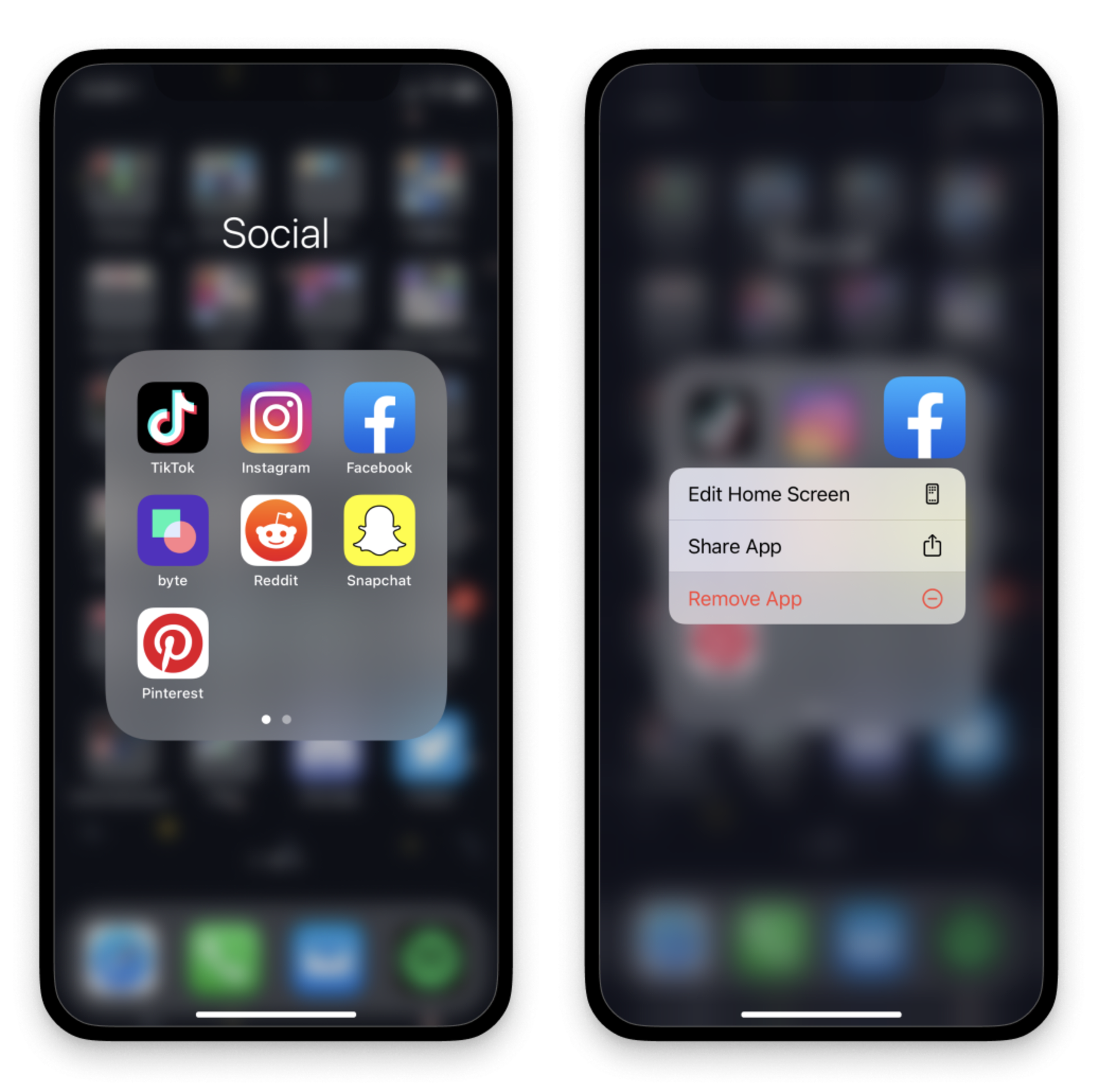
Here are two tips for cutting back on social media:
- Try time tracking: Use apps like RescueTime or the native app-tracking features on your mobile device to see exactly where you spend your time. What gets measured gets managed.
- Make access harder: Try deleting social apps from your phone. Often, we reach for distractions when they’re in close proximity. Creating a barrier to checking for our apps can help us be more intentional about the time we spend online.
Busy work
There’s a range of tasks that we do every day or week that fill our hours but fail to move us forward. Here’s a list of to-dos you might recognize:
- Sorting through your inbox and responding to emails
- Keeping up with messages in your company’s team chat app
- Spending time on repetitive administrative work
- One-off work tasks untied to a larger objective
- Urgent last minute requests
These tasks have a way of derailing our days, making us put off what we intended to get done. Recognizing the work that’s impactful and the work that isn’t will help you prioritize. We can’t do the ambitious work that gets us promoted at work if we’re bogged down with the basics.
Here are a few strategies for getting rid of busywork:
- Delegate or outsource: Whenever possible, pass on work to others within your organization that doesn’t fit your criteria of “impactful work”. Alternatively, seek out freelancers and contractors for work you find unchallenging or outside the capabilities you want to develop.
- Automate: Use an app like Zapier to automate repetitive administrative tasks you find yourself doing again and again, like notifying your team about new leads or saving new files to your cloud app.
- Constrain: For low-leverage tasks that need to get done, limit how much time you spend on them. For instance, answer emails once per day rather than as they arrive in your inbox.
- Say no: Let go of guilt and recognize that you need to put your priorities first. Saying “no” gets easier with practice.
Negativity
A less-discussed distraction that prevents us from prioritizing properly are life’s tough moments and the accompanying negative thoughts that swirl around in our heads. The time and mental energy we spend dwelling on situations outside of our control — or doubting our abilities and comparing ourselves to others — could be spent doing the work that will propel us towards the lives we want.
Moving our focus away from what’s bad and bleak is easier said than done. Our minds are designed to fixate on the negative — a cognitive bias that sometimes prevents us from seeing reality clearly.
Use these strategies to curb your negative thought patterns:
- Keep a brag document: Maintain a running record –– whether it’s a document or folder –– of the kind and positive things people have said about you. While we shouldn’t always reach for external validation, hearing nice things from others is impactful when we’re feeling down. Screenshot and/or write down compliments you’ve received, both personally and professionally, and look back at your collection when you’re feeling down.
- Monitor your inner self talk: Cultivate mindfulness and awareness around your inner thoughts. When negative thoughts arise, ask yourself if they're comments you might say to a close friend or a child.
- Have empathy: When negativity is from an external source –– like when people say or do hurtful things –– it can be a result of their own inner turmoil and personal problems. We have little access to people’s inner worlds and should aim for understanding whenever possible. However, empathy for others should not be in conflict with empathy for ourselves. Be firm with people who act unkindly and remove yourself from negative situations.
Prioritizing health, happiness, and everything else we value is easier when we’re in the right mindset and environment.
9 Strategies for Prioritizing Your Tasks
How to prioritize starts with knowing exactly what matters in life and what doesn’t. The next step is using tactical strategies to ensure your priorities rise to the top amid the busyness of life.
1. Capture all of your tasks in one place
Work requests from email, personal tasks like cooking meals, and new ideas for projects are all floating around in our heads. Unfortunately, this makes it challenging for us to prioritize them, rank them by importance. The first step to prioritization is gathering all these to-dos in one place.
Make a habit of adding each new task into a productivity system – a central place to encapsulates everything you need to do and when you need to do it. This system can be pen and paper or a digital system like Todoist that lets you add tasks on both your phone and computer. This important thing is the habit of capturing all of your to-do's. Pick the tool that's the easiest for you to stick to.

2. Stay focused by eliminating distractions
Social media and entertainment can curtail our best intentions. How can we reduce their pull on our lives? By blocking them out. Regularly use an app blocker, like Freedom (MacOS, Windows, Android, iOS) or Self Control (MacOS) to reduce the amount of time you spend online.
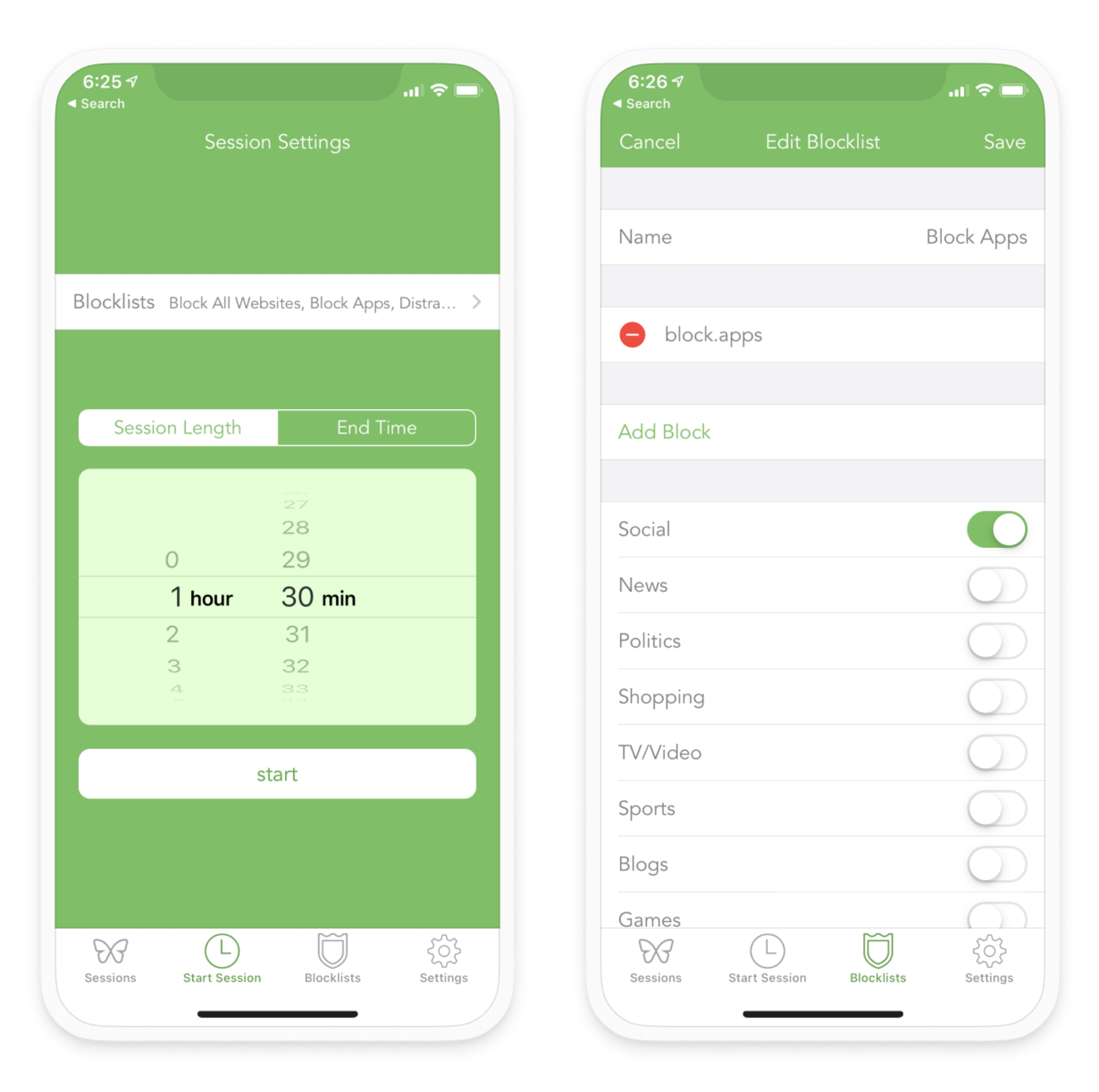
Freeze your access to social media and news sites intermittently or for extended periods of time when you need to get things done. When social media isn’t an option, we open up the opportunity to focus on our top priorities.
3. Don’t fall for shiny object syndrome
With a productivity system in place and a method for blocking digital distractions, there remains a category of diversions that can derail our priorities and keep us from working on what we intended: something new.
When boredom creeps into our routine, it’s easy to fall for shiny object syndrome. Any novel idea that comes our way manages to capture our attention and distract us from our initial focus:
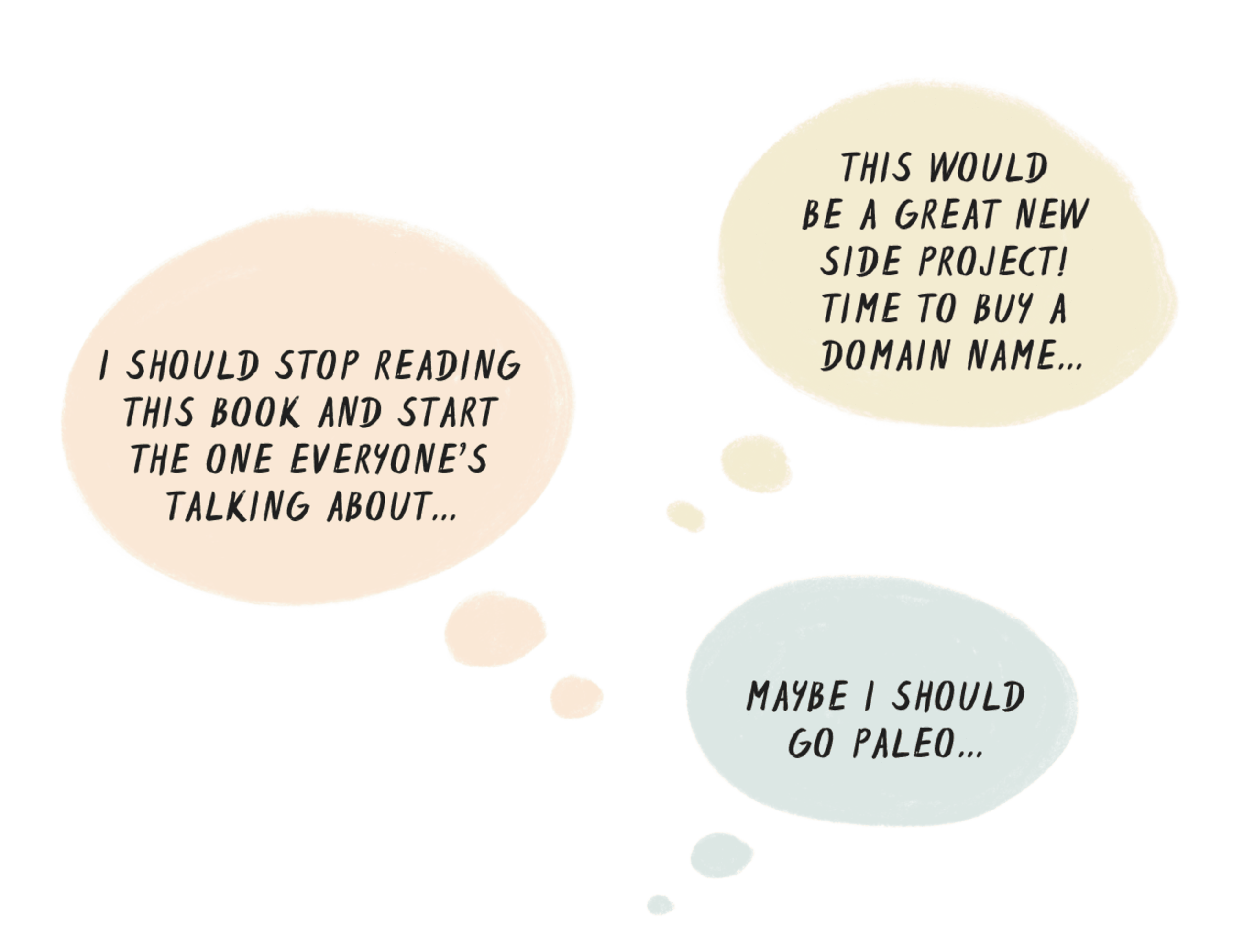
Jumping from trend to trend and project to project prevents us from making progress on what's important to us. We’re always starting anew, never truly finishing. Progress happens in the long term and our efforts compound overtime. Consistently switching our strategy and trying the next new thing keeps us scattered and unfocused.
Give what you’re working on a true chance. Commit to a new habit for six months not six days and resolve to finish a side project before starting a new one. When something gets challenging at work dig into how it could be resolved instead of browsing job postings. Prioritizing often means seeing things through rather than giving up at the first sign of a challenge.
Author and productivity expert, James Clear, provides sound advice for sticking to tasks even when they become mundane — fall in love with boredom:
“Somehow, top performers in any craft figure out a way to fall in love with boredom, put in their reps, and do the work.”
4. Understand importance over urgency with the Eisenhower Matrix
We tend to believe that there’s all the time in the world to read the books we want, see the people we love, and check off all the things on our bucket list. So we put them off. We don’t prioritize them. Instead, we prioritize the things that are urgent –– a looming deadline at work or an incoming email start to take precedence over the important things in our lives.
This tension is the basis of the Eisenhower Matrix productivity method. The system forces you to visualize your tasks as belonging to one of four separate categories:
- Urgent & Important tasks/projects to be completed immediately
- Not Urgent & Important tasks/projects to be scheduled on your calendar
- Urgent & Unimportant tasks/projects to be delegated to someone else
- Not Urgent & Unimportant tasks/projects to be deleted
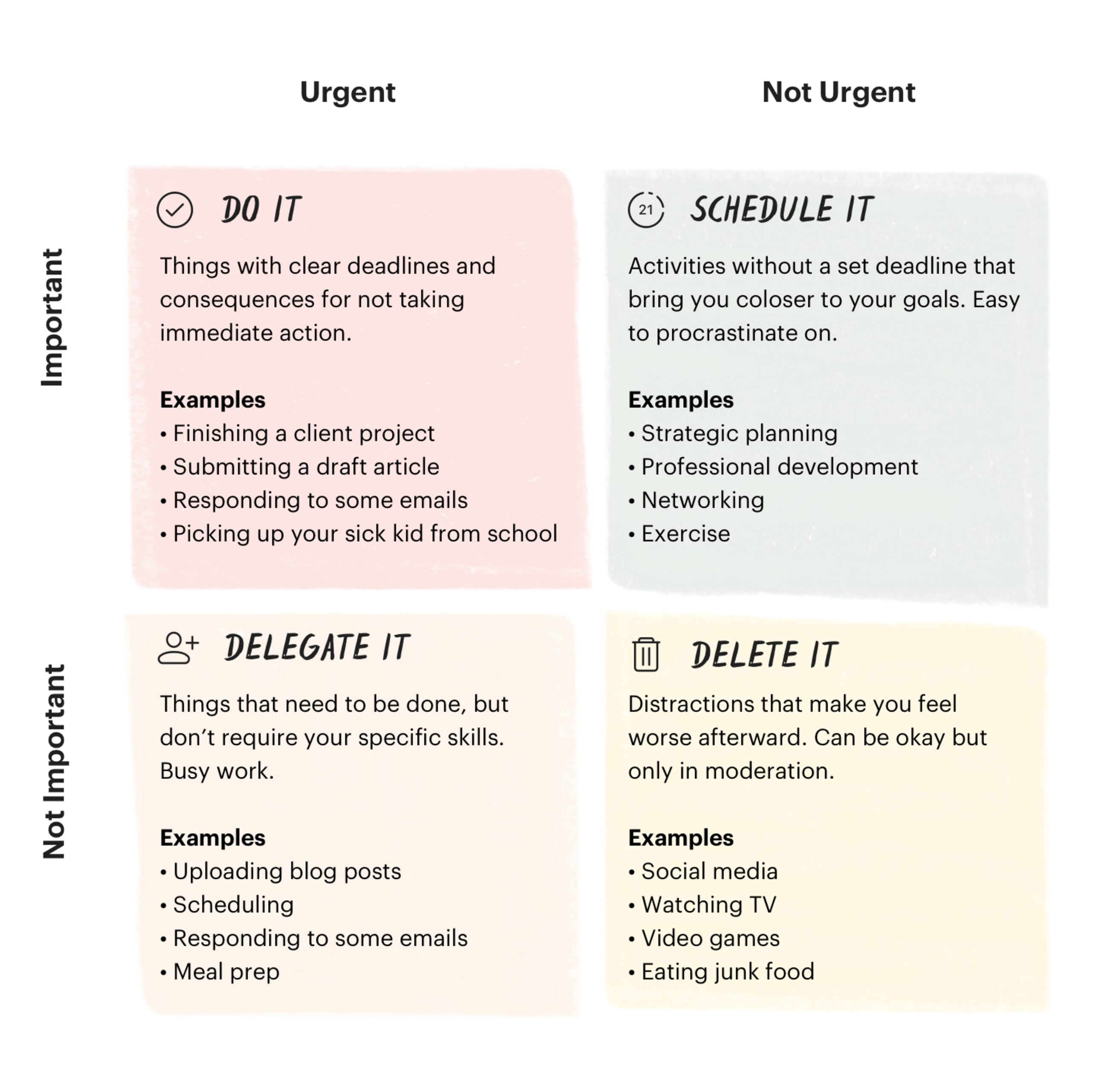
Be aware of the difference between urgent and important and opt for the latter as much as possible. Here are a few examples:
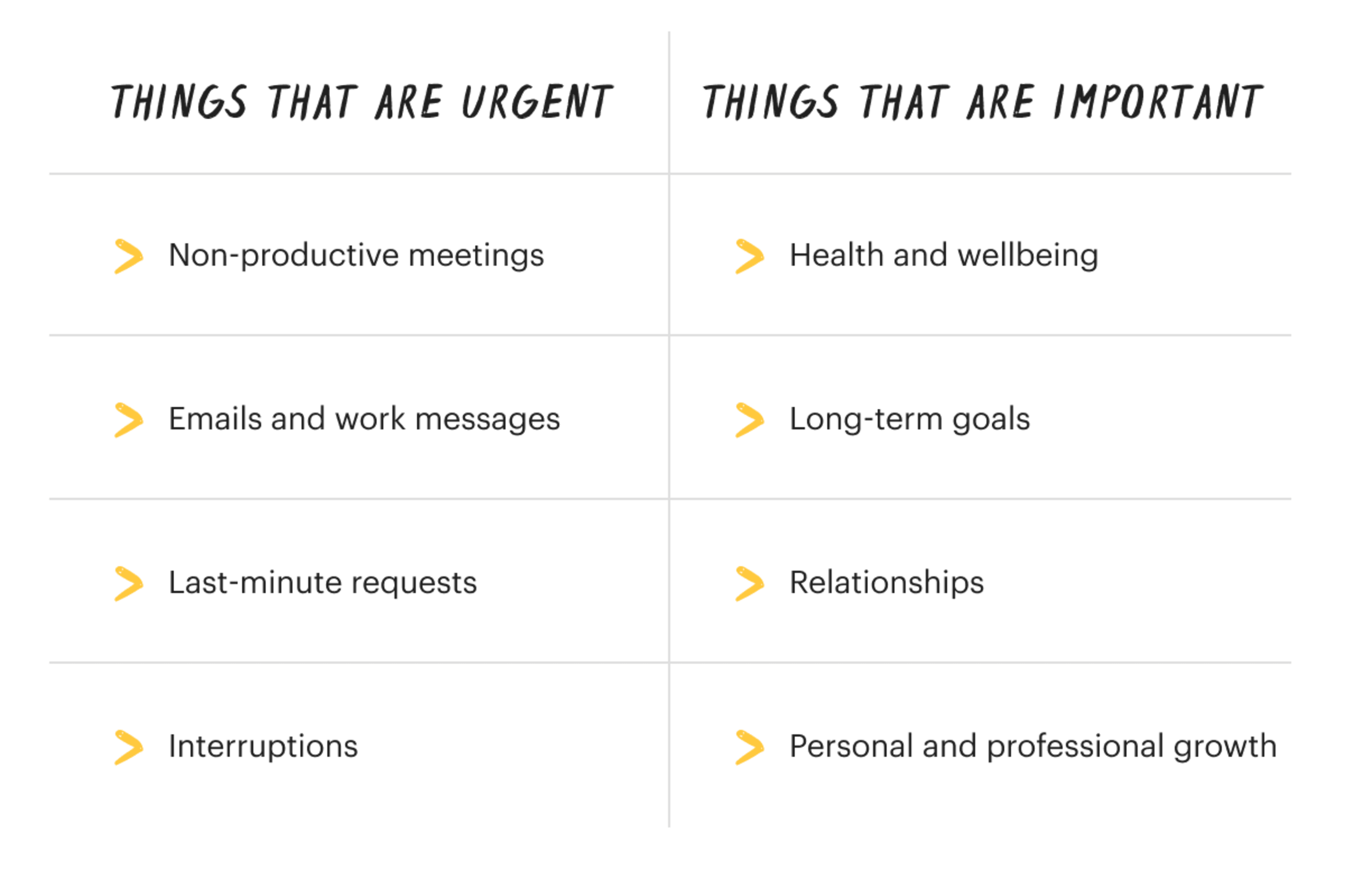
Calling your Grandmother or going for a walk will never have the frantic urgency of a deadline at work, but those are the kinds of important things that make our lives more fulfilled and balanced in the long-run.
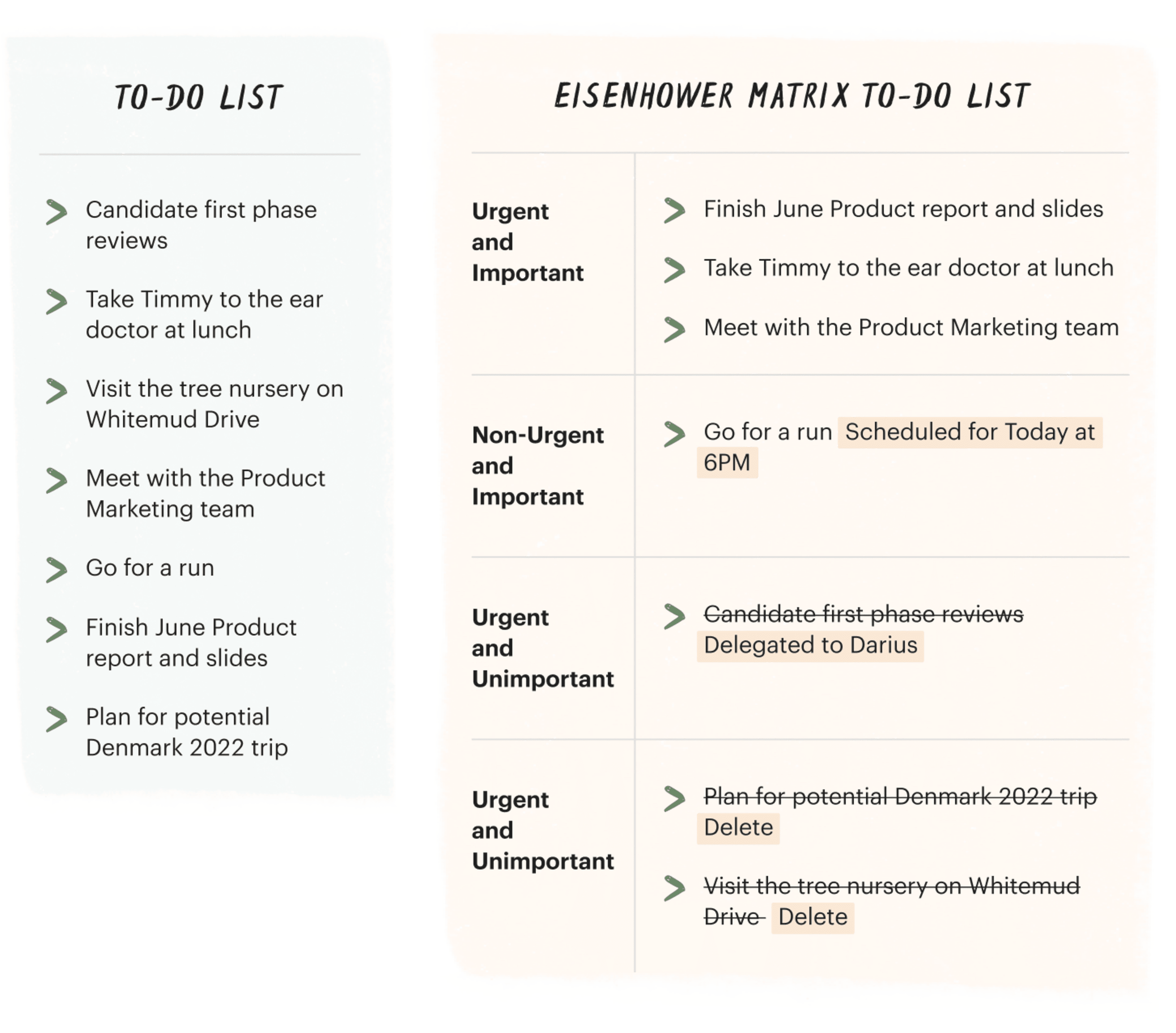
5. Manage your energy, not your time
In between eight or more hours at work each day and the other eight hours we should reserve for sleep, there’s only so much maneuvering we can do to prioritize what’s important in work and life. Instead of watching the clock, side step time management in favor of energy management.
Daniel H. Pink’s When: The Scientific Secrets of Perfect Timing discusses a pattern that many people around the world exhibit: positive affect (“emotions such as enthusiasm, confidence, and alertness”) is high in the morning, dips in the afternoon, and rises again in the evening.
We can use this information to our advantage, planning for our priorities to bookend our days and using our low mood hours for low-priority work.
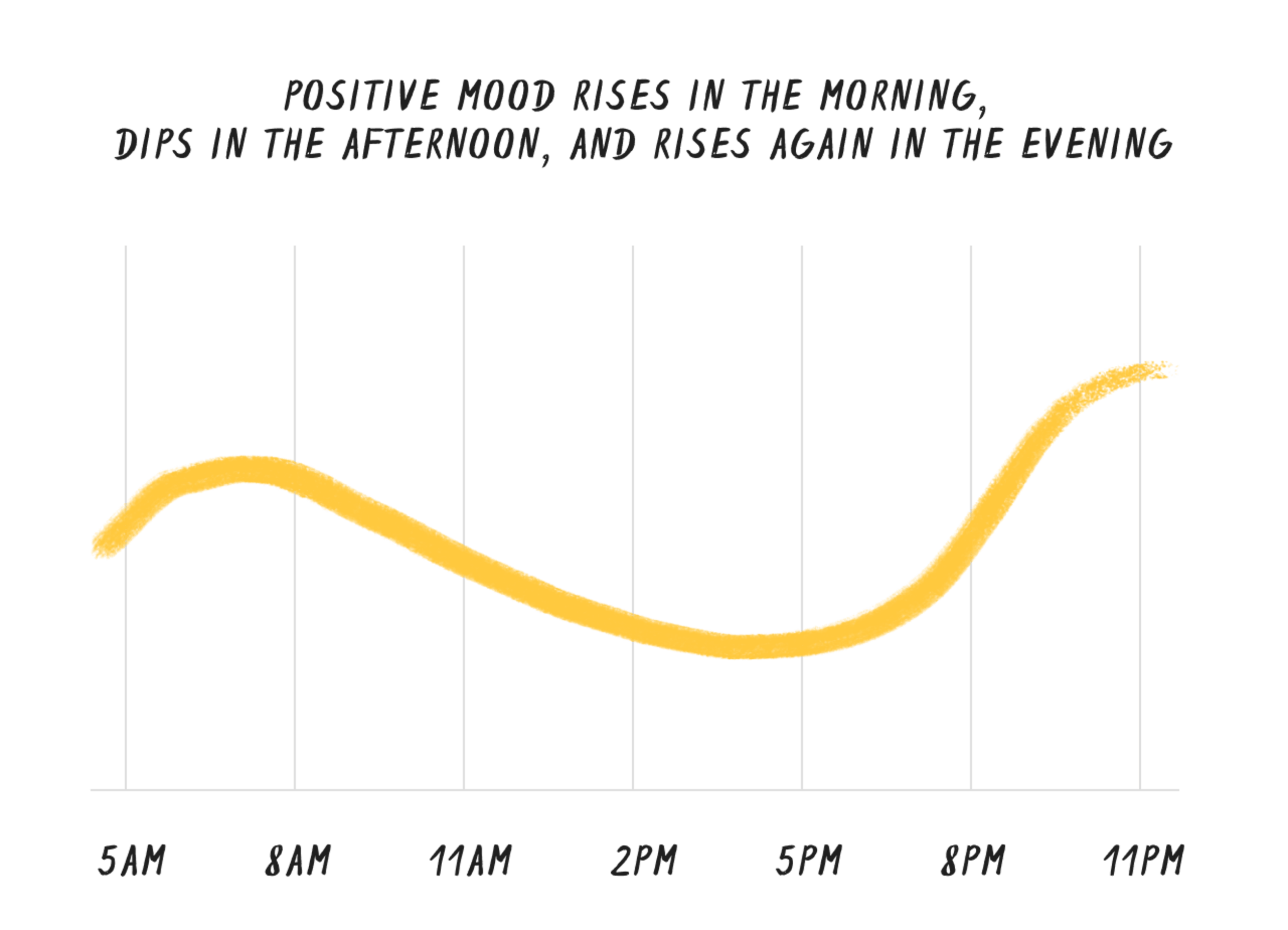
Naturally, there are exceptions. It’s worth figuring out when you’re most productive and scheduling your high-priority tasks accordingly:
- If you’re an early bird, prioritize your most important tasks for right after you wake up.
- If you're a night owl, conserve your late nights for priority projects you want to make progress on.
- As a parent your “productive” time may be limited to when your kids are at school or sleeping. Protect those hours at all costs for your own priorities.
Whenever your most productive hours are, block them off in your calendar and make appointments with yourself to keep your priorities straight.
6. Take stock of what’s important with The Commitment Inventory
Many of us are overstretched with little time to focus our energy where we want to. The Commitment Inventory productivity method makes us take stock of all our commitments and forces them to reassess them.
Here’s how to implement the method:
- Create an exhaustive list of everything you spend time on
- Consolidate into categories and assign a percentage to each
- Trim your list of commitments, making sure each category has enough time to do it well
- Organize your to-do list around your categories
- Break big tasks down into checklists
- Work in timed “bursts” aligned with your categories
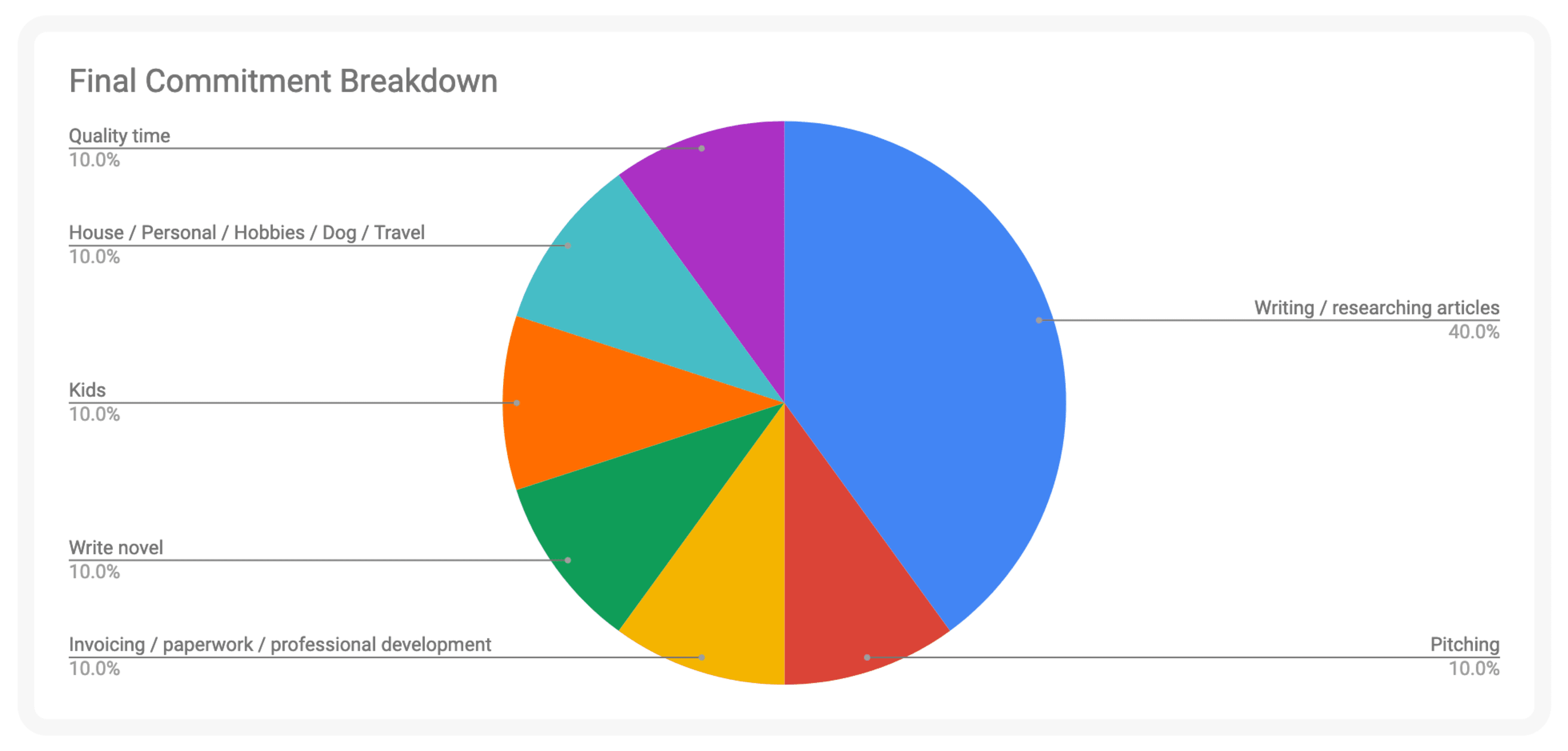
When you’re trimming your commitments, ensure your priorities are reflected in your remaining categories and find their way onto your daily to-do lists.
7. Put your most important task first with Eat the Frog
A simple productivity method worth trying is Eat the Frog. This method is simple, but not exactly easy –– here are the steps:
- Identify your frog: also known as your hardest, most important task for the day.
- Eat it: do your most important task first thing in the morning. Don’t give yourself the chance to put it off for later.
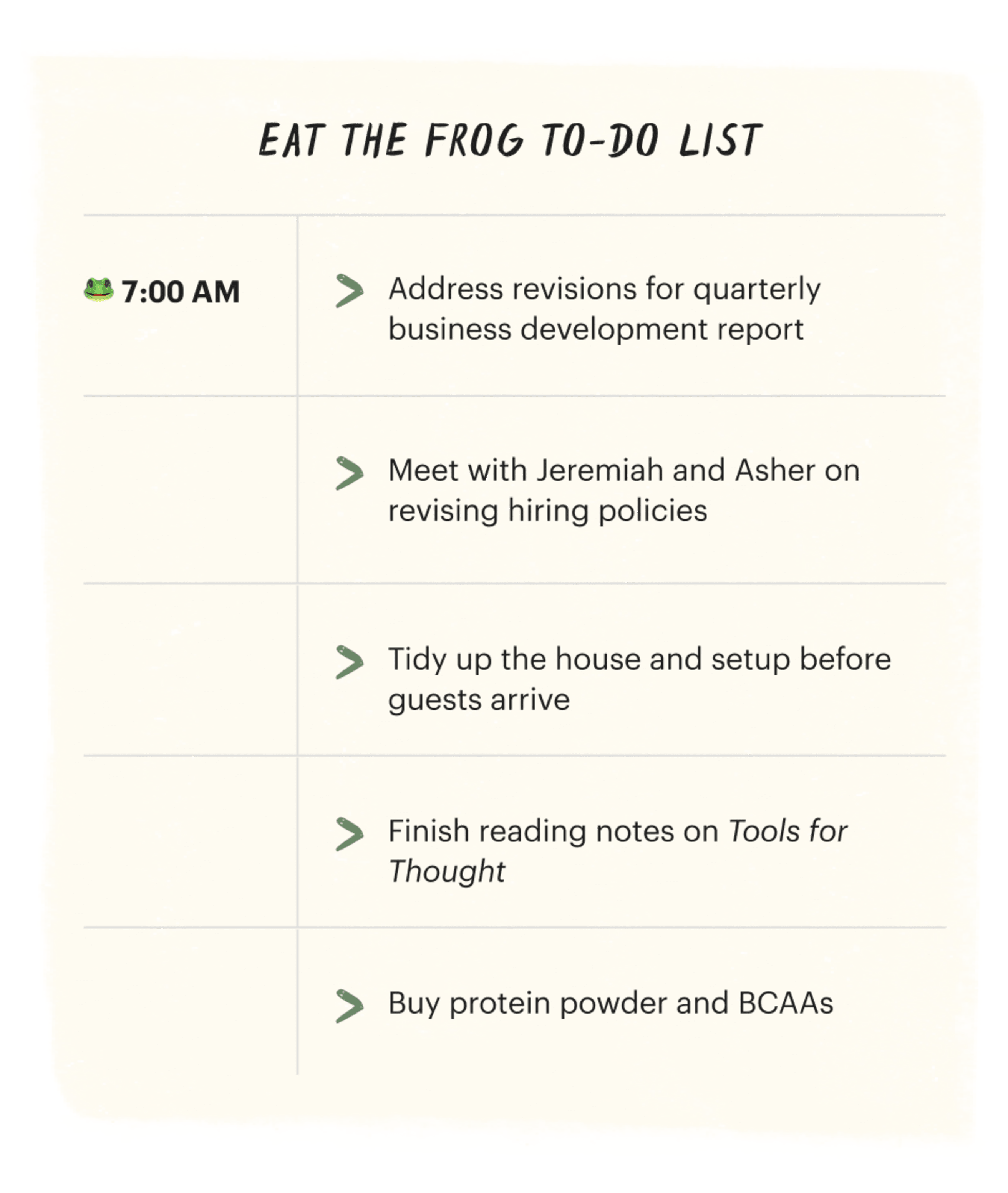
Consistently using this productivity method will help you prioritize something important each and every day and build momentum for the hours ahead. Consider some of the following tasks as your “frog”:
- Hacking on your side-project before checking email
- Getting in exercise right after waking up
- Writing 1000 on your novel before work
Chances are, you probably know what your frog is: often what we need to prioritize the most is the task we adamantly avoid. Test your resolve, grit your teeth, and do the hard thing.
8. Account for your hours with the Time Blocking method
The Time Blocking productivity method forces you to plan your day hour by hour, batching similar tasks together instead of multi-tasking and context-switching throughout the day. Doing so can be especially helpful for prioritizing because it underscores exactly how many hours we have in a day and forces us to make the trade-offs we find so difficult.
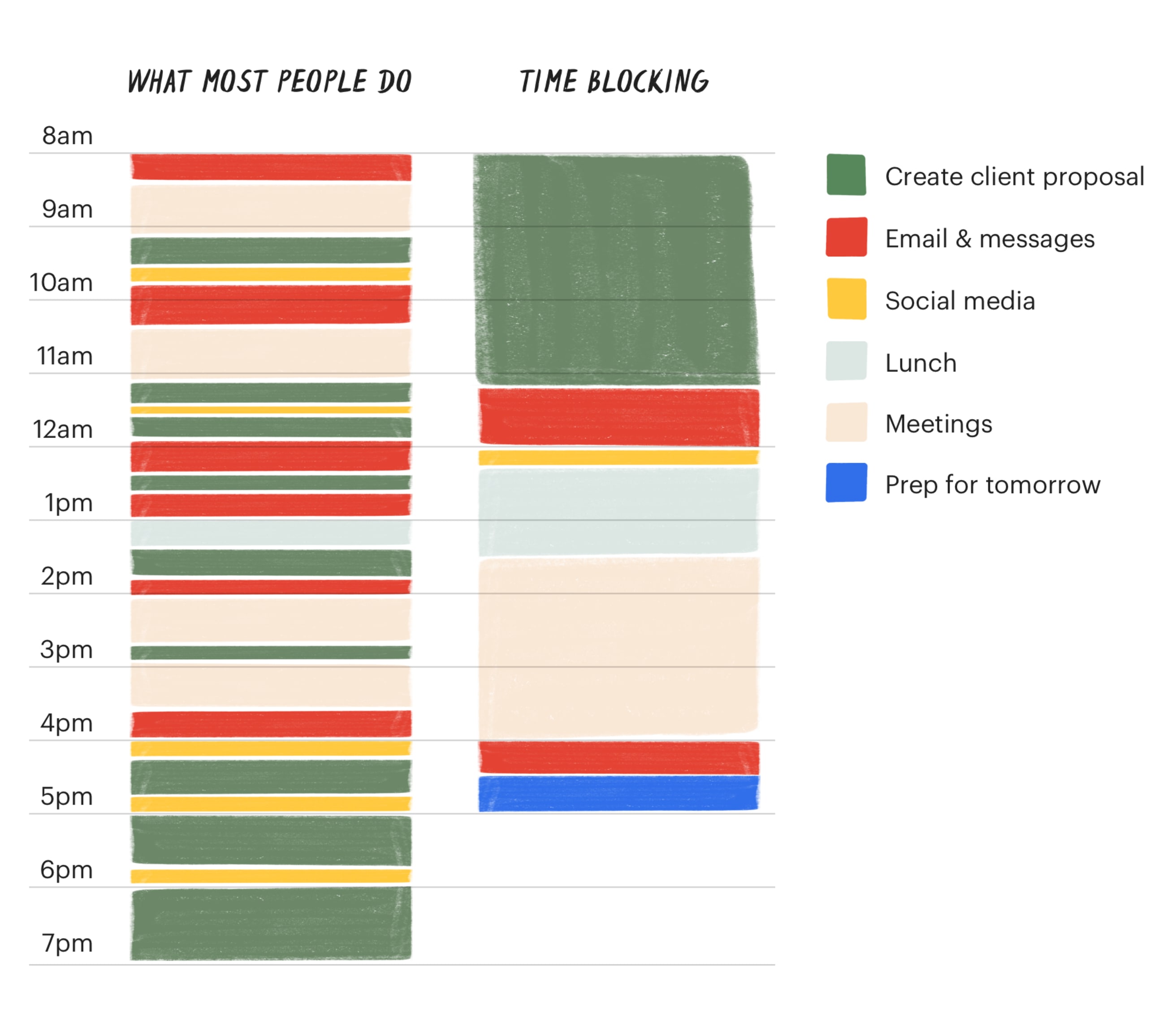
Here’s how to implement the Time Blocking method:
- Make a to-do list for the day
- Categorize your tasks together in similar “blocks”
- Estimate how long each block of tasks will take you
- Add each block to your schedule sequentially with a time attached
- Complete each block of tasks from morning to evening in order
- Shift, modify, or postpone blocks of time when necessary
Each day, ensure that at least one of your blocks of time is related to your top priorities like high-impact work projects and time spent learning.

9. Eliminate non-priority tasks with Warren Buffett’s “2 List” Strategy
We often think of prioritization as deciding what we will work on. It can be more powerful to decide what to let go of. Warren Buffet’s “2 List” Strategy focuses on getting rid of the tasks holding us back from our true priorities. Here’s how to use it:
- Write down 25 things you want to accomplish
- Select your top 5 priorities from this list
- Cross out the remaining 20 items and actively avoid thinking of them
- Focus only on your top 5 priorities.
Our instinct is to let our second tier "priorities" hang around to keep our options open. It keeps us from focusing and committing to our goals. Instead of keeping your options open, limit them.
5 tips for prioritizing tasks in Todoist
Use Todoist to keep your priorities straight and to plan your days, weeks, and months with your important tasks front and center. This section will discuss the best features to surface high-priority tasks so they always have a prominent place on your to-do list.
Create projects for your life
For each of the important areas of your life, create a dedicated Todoist project. For instance, create projects like “Home”, “Family”, “Personal”, “Social”, “Fitness”, and “Work” for all your tasks related to these areas. Add tasks like “Go on a run” to your “Fitness” project and “Tidy my home office” to “Home”.
It’s easy to let our “Work” project fill up and take up the lion’s share of our days. To prevent this, regularly look at your Today view in Todoist to ensure that you’re prioritizing different areas of your life too. For example, ensure you have both tasks in your “Family” and “Personal” projects on your list for the day. Think of your projects as a prioritization filter. If a task doesn't fit into one of your projects, ask yourself if it's worth spending your time and attention on. However, feel free to also create a “Someday” or “Maybe” project for things you don't have time for right now –– give yourself permission not to think about them.
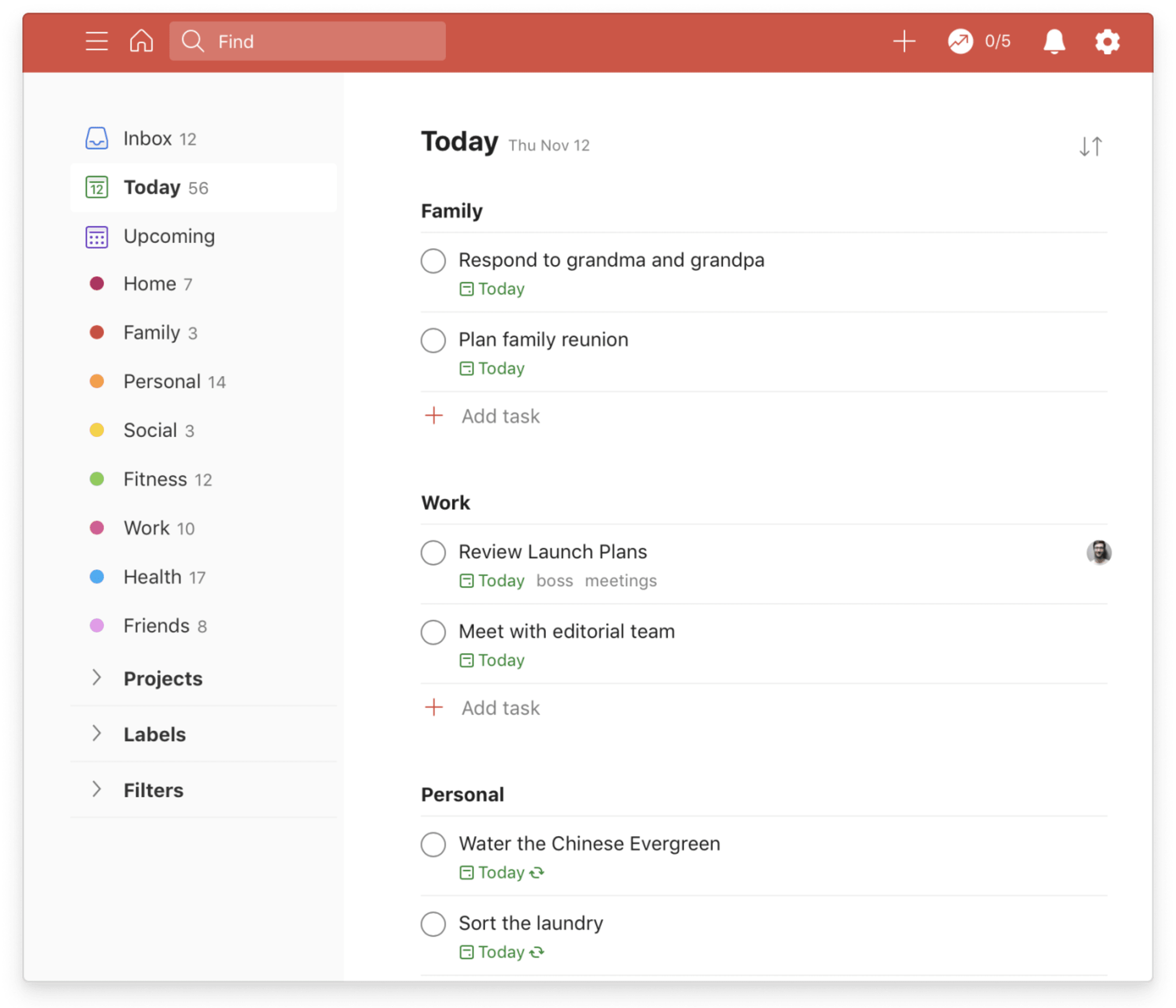
Balance the week ahead with upcoming view
It’s not possible to prioritize all the important areas in our life in a given day. That’s okay. We can adopt longer time horizons by planning with Upcoming view in Todoist. While you might not have time for yoga this afternoon, fit it in later this week. Getting ahead of your menu with meal prep may not be in the books for this evening, but schedule it for Saturday afternoon. Plan for the week and beyond with your priorities in mind.
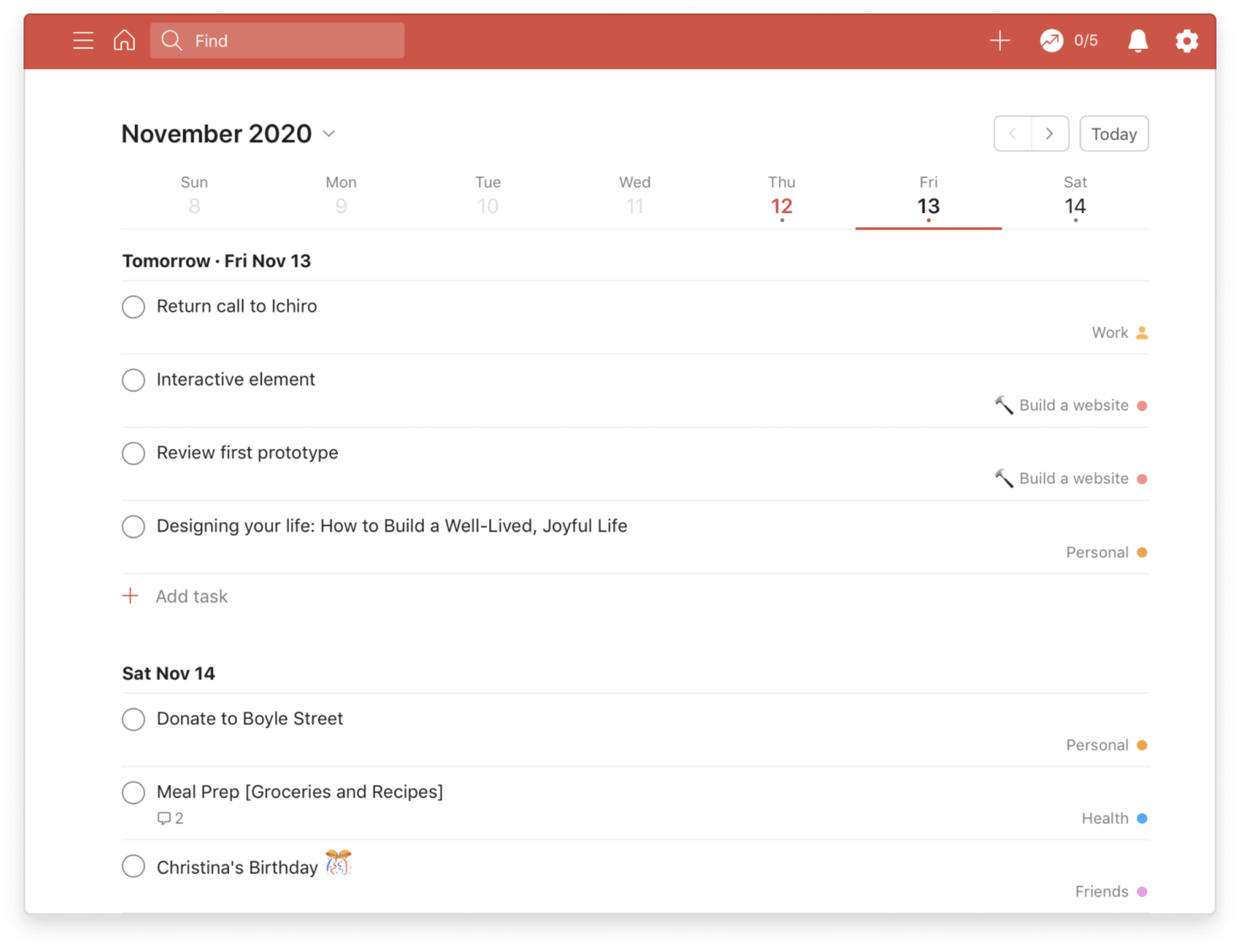
Add priority levels to your tasks
Even with proper planning and all our tasks in front of us, it can be overwhelming to know where to start. Assign priority levels to your Todoist tasks so you have a logical order of what you should work on first, and what should be moved to the bottom of your list or postponed.
There are four priority levels in Todoist:
- Priority 1 (red)
- Priority 2 (orange)
- Priority 3 (blue)
- Priority 4 (clear)
Adding priorities to your tasks ensures they appear at the top of your Todoist task list for visibility.
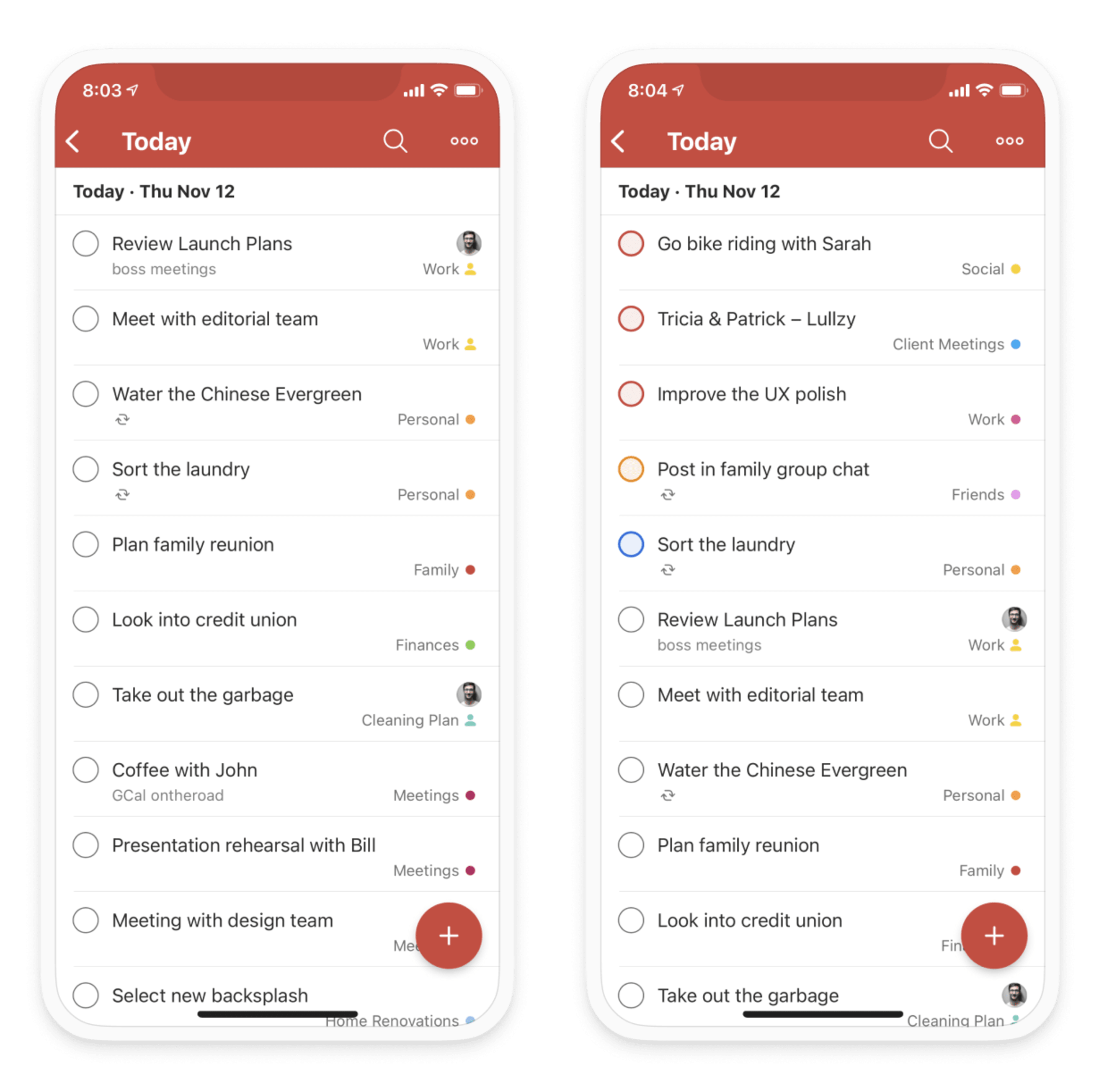
We recommend using priorities sparingly. If everything is a priority, nothing is. Instead, limit priority tasks to 5 per day and ensure they’re not all work-related tasks. Choose 5 tasks that you would feel great about accomplishing if nothing else got done that day.
Add important projects, labels, and filters to your Favorites
When you’re used to Todoist, you tend to create a project for everything. Movies to watch? Project. Things to buy? Project! This is a great system to use because everything you need or want to do exists in the same place. However, when it comes to prioritizing, a long list of projects makes it harder to decipher what’s for today and what’s for tomorrow.
Use Todoist Favorites to bookmark your most important projects for easy access.This way, your top priority projects will be right under Upcoming View, whether you’re on desktop or mobile. Bookmark projects like “Health” and “Friends” so they don’t fall to the wayside.

Get rid of old tasks with Todoist filters
The productivity system where you add just about everything is bound to accumulate some digital cobwebs. Over time your Todoist lists will include outdated tasks, long-forgotten projects, and priorities you’re no longer prioritizing. Use Todoist filters to surface your old tasks so you can get rid of them.
Create a filter called “Old tasks” with the query “created before: September 10 2018”. This will surface tasks that are over two years old. Then, delete them. Give yourself permission to delete the to-do’s that have been on your list for too long.
Whether we’ve prioritized the right thing or not is easiest to know in hindsight. Failing to reach our goals can be a good indicator that we’ve prioritized the wrong things. Drifting apart from close friends and family is an indicator that we haven’t placed enough importance on our relationships.
However, we don’t need to wait until it’s too late. Instead, reassess on a regular basis whether your stated priorities are reflected in where you spend your time. By prioritizing what matters, we can reach our goals, meaningfully balance life and work, and start and end each day with intention.

